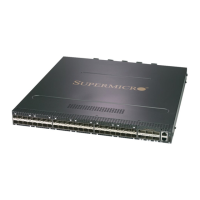Supermicro SSE-F3548S/SSE-F3548SR Configuration User’s Guide
9.2.2 Scheduling
Supermicro switches support eight CoS queues for each egress port. For each of the eightqueues, various
typesof scheduling can be configured:
Strict Priority
Strict priority scheduling is based on the priority of queues. Packets in ahigh-priority queue arealways sent
first and packets in alow-priority queue are not sent until all the high-priority queuesareempty.
Round Robin(RR)
Using the round-robin (RR) scheduling algorithm, packets in queues are transmitted in a FIFO manner,i.e.
one packet after the other. All queues havethe same priority and weight in an RR configuration.
Weighted RoundRobin (WRR)
In WRR scheduling, theuser specifies a number to indicate the importance (weight) of thequeue relative
to the other CoS queues. WRR scheduling prevents low-priority queues frombeing completely neglected
during periods of high-priority traffic. The WRR scheduler sends somepackets from each queue in turn.
The number of packets it sends corresponds to the relativeimportance of the queue. By using WRR,low-
priority queues can send packets even when high-priority queues are not empty.
DeficitWRR
Bandwidth allocation can be unfair when the average packet sizes are different between the queues and
their flows. This behavior can result in service degradation for queues with smaller average packet sizes.
Deficit Weighted Round Robin (DWRR) is a modified weighted round-robin scheduling that can handle
packets of variable size.
9.2.3 Default Priority
The Class of Service (CoS) priority field is taken from the VLAN header of a received packet. If the received
packet does not have a VLAN header, the default port priority is used as the CoS value. Supermicro
switches provide an option to configure the default priority.
Figure QoS-4: VLAN Tag and CoS Priority
In the above figures, CoS priority is a 3-bit field in a tagged frame that indicates the frame priority level,
ranging from 0 (best effort) to 7 (highest) with 1 representing the lowest priority. These values can be
used to prioritize different classes of traffic (voice, video, data, etc.).
For IEEE 802.1Q frames with tag information, the priority value from the header frame is used. For native
frames, the default priority of the input port is used. Supermicro switches allow users to configure the
default port priority.
CoS C
Priority F VLAN ID
I

